
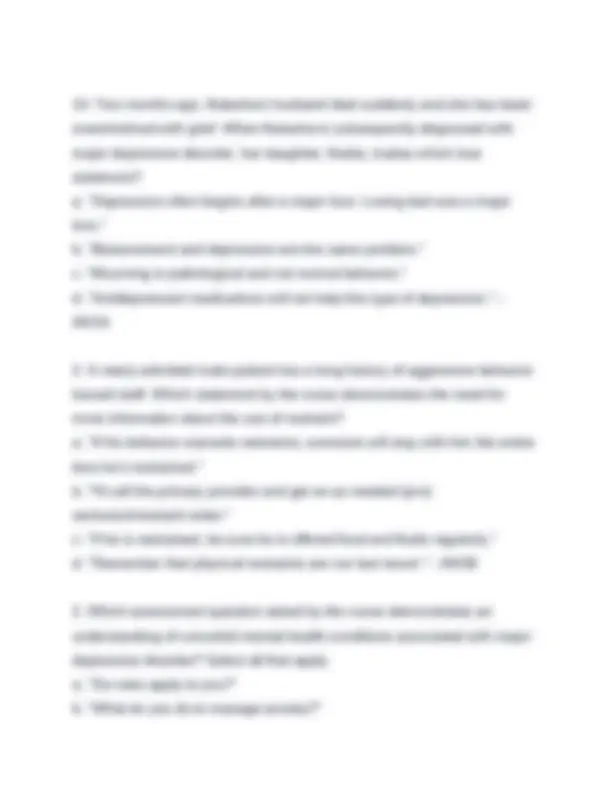
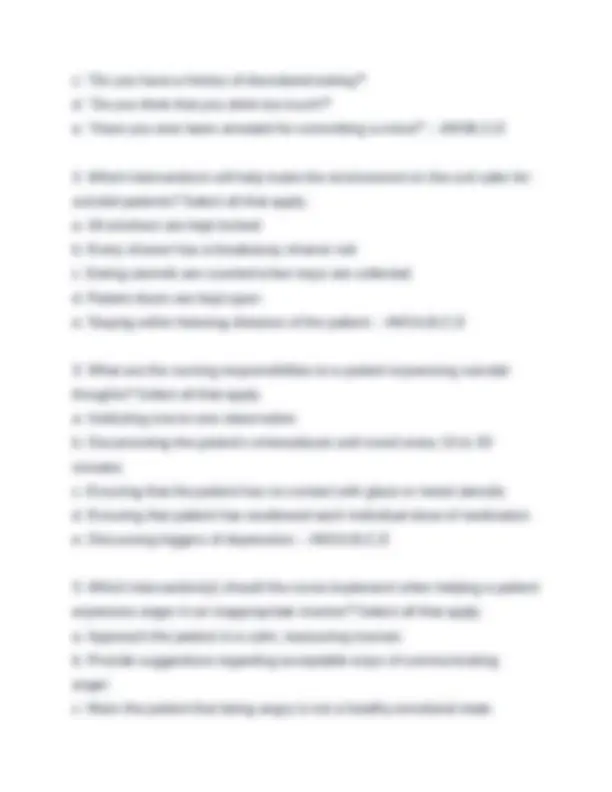
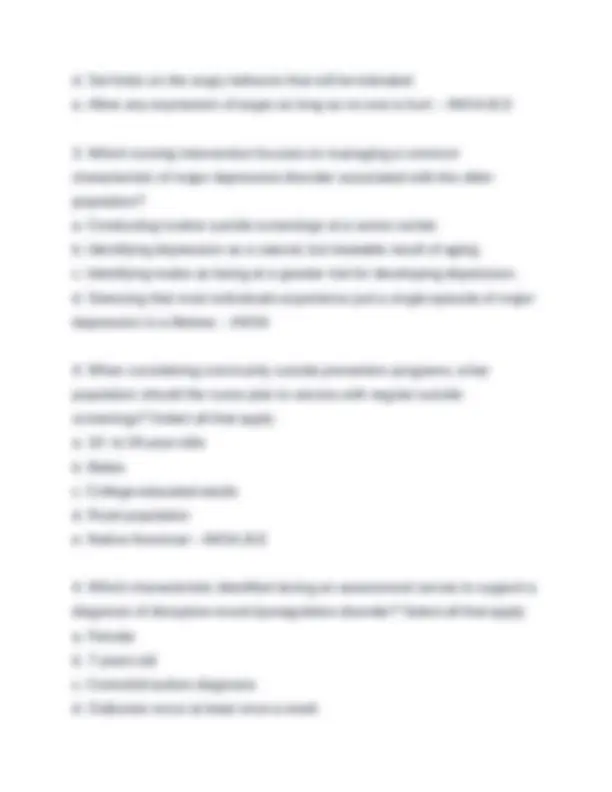
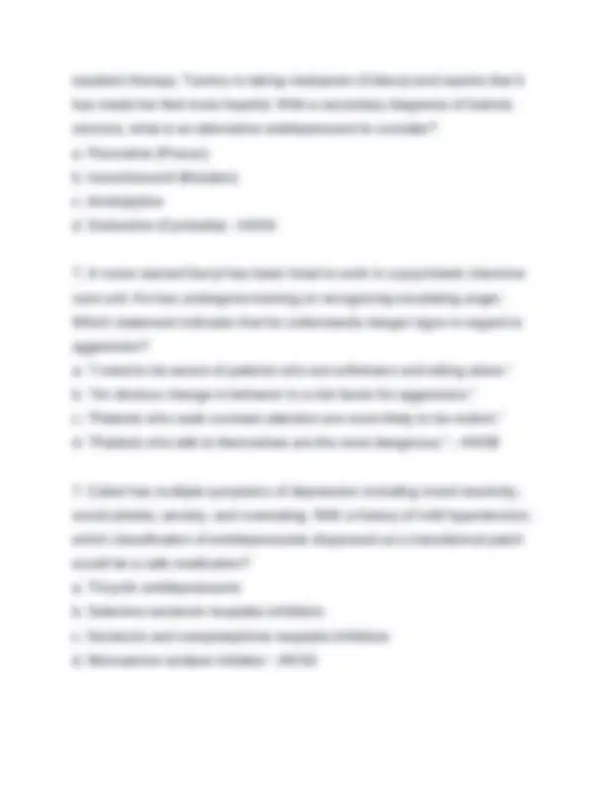
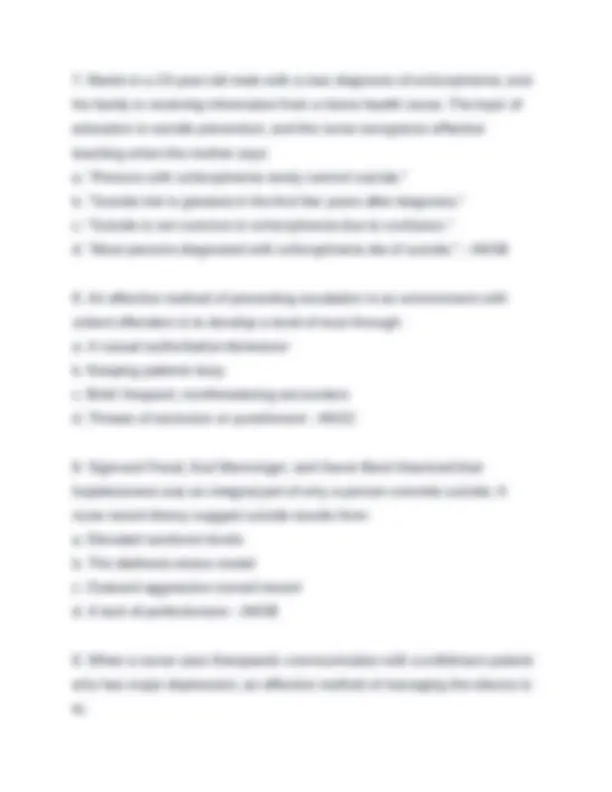
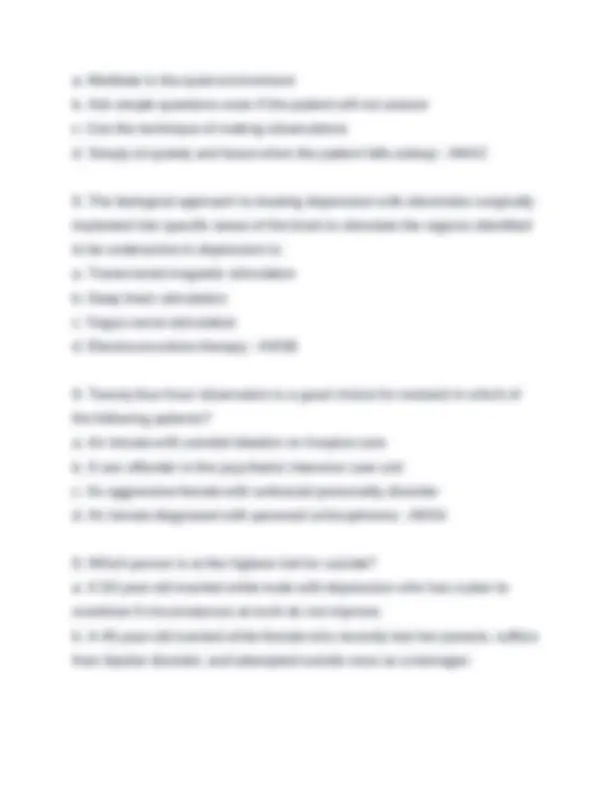
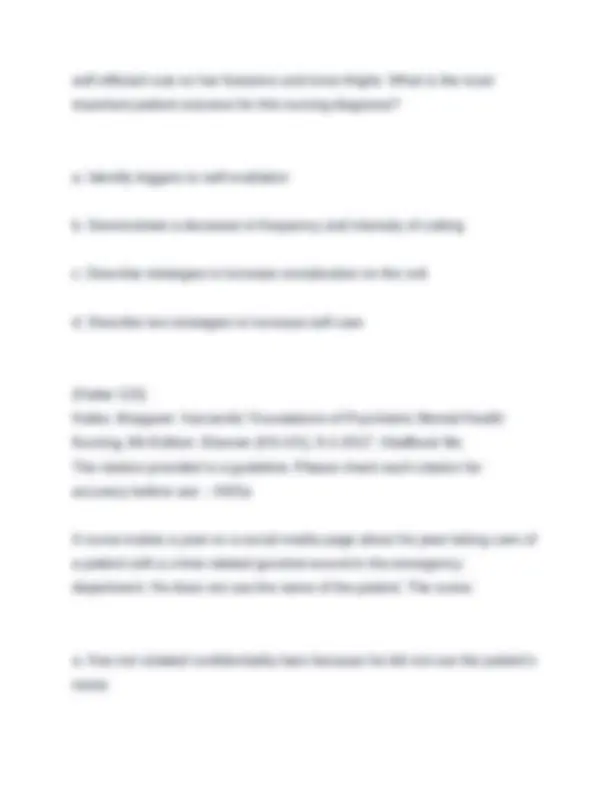
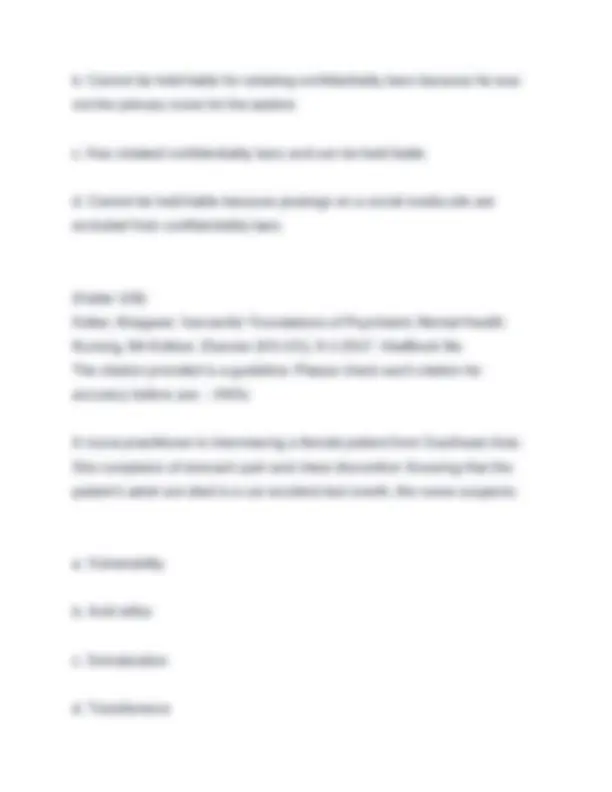
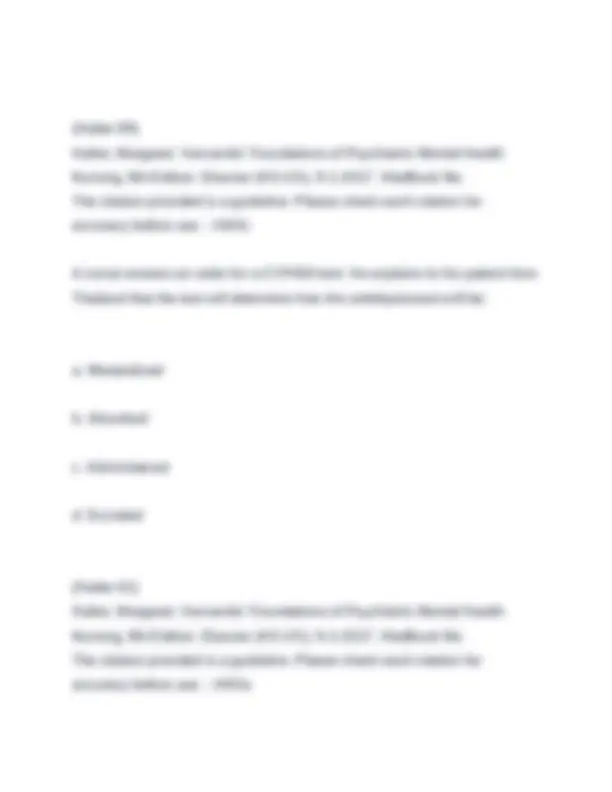
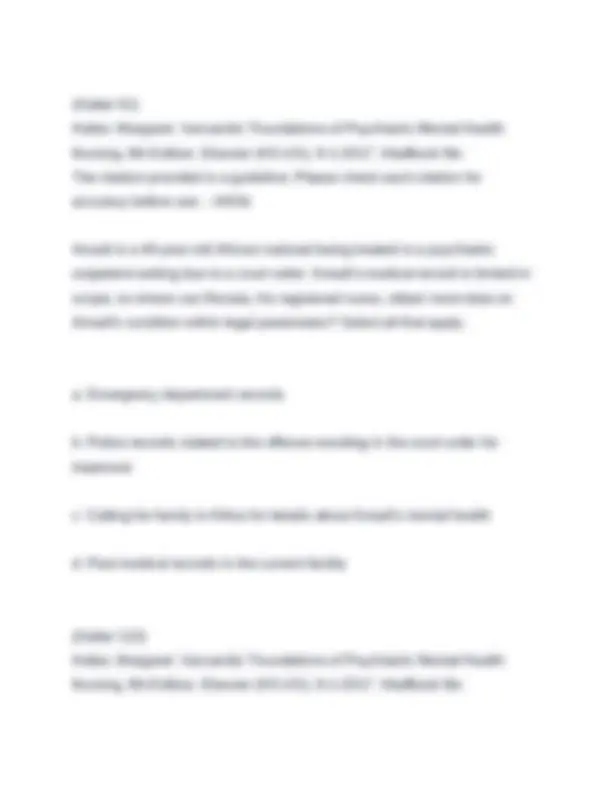
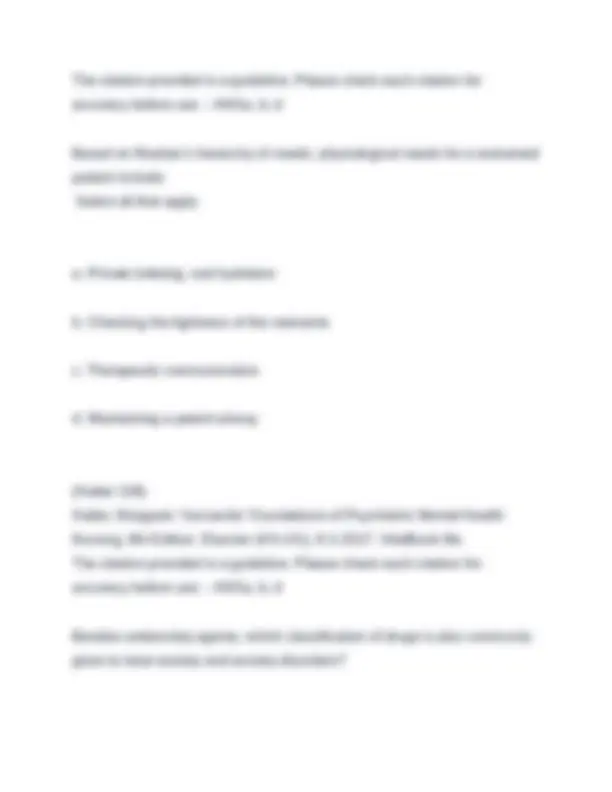
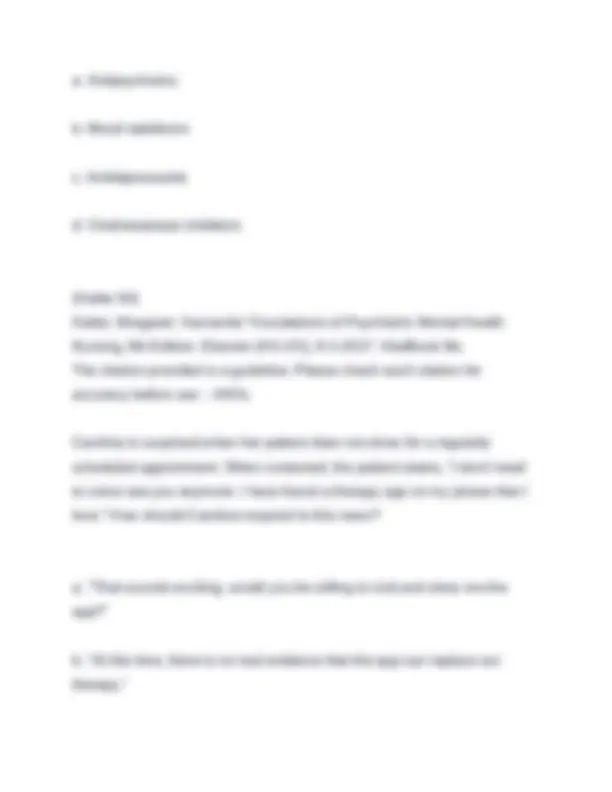
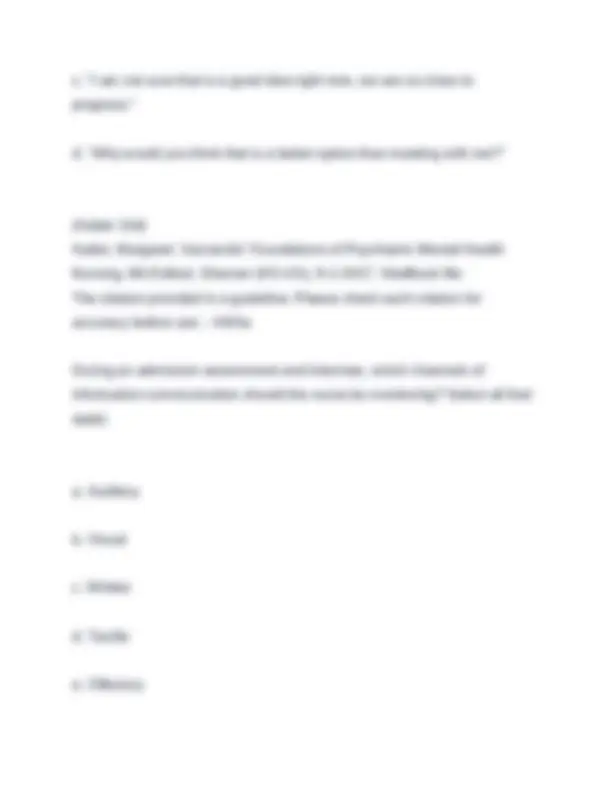

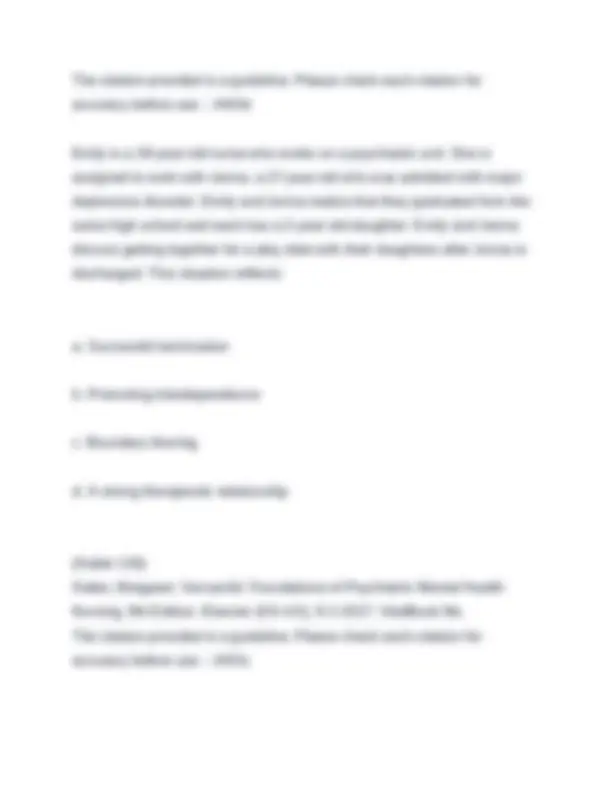
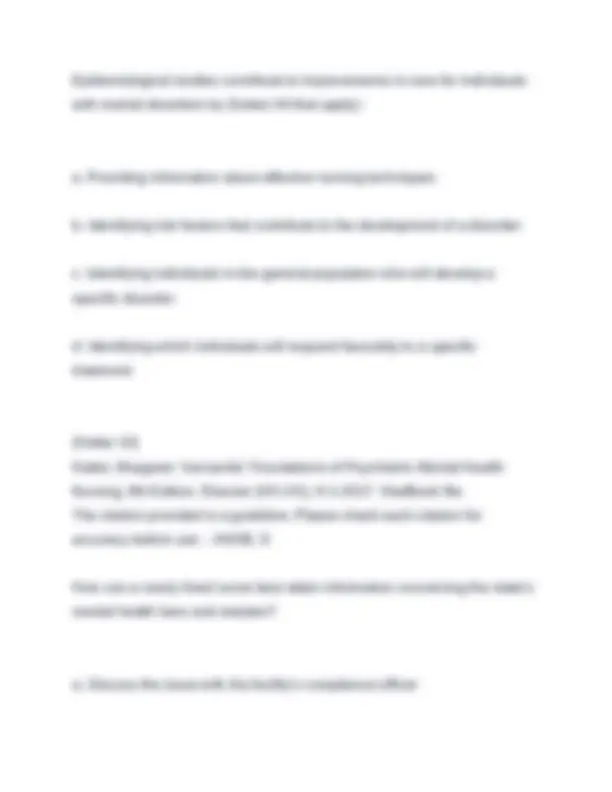
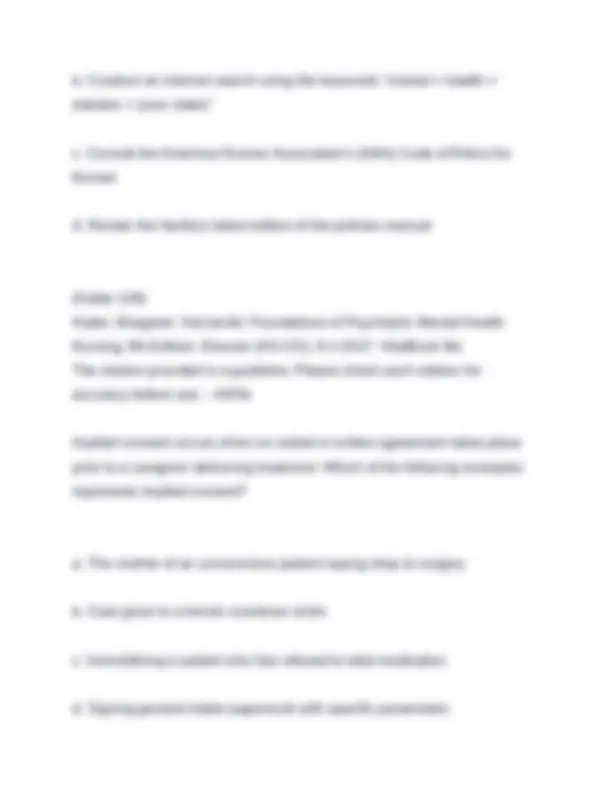
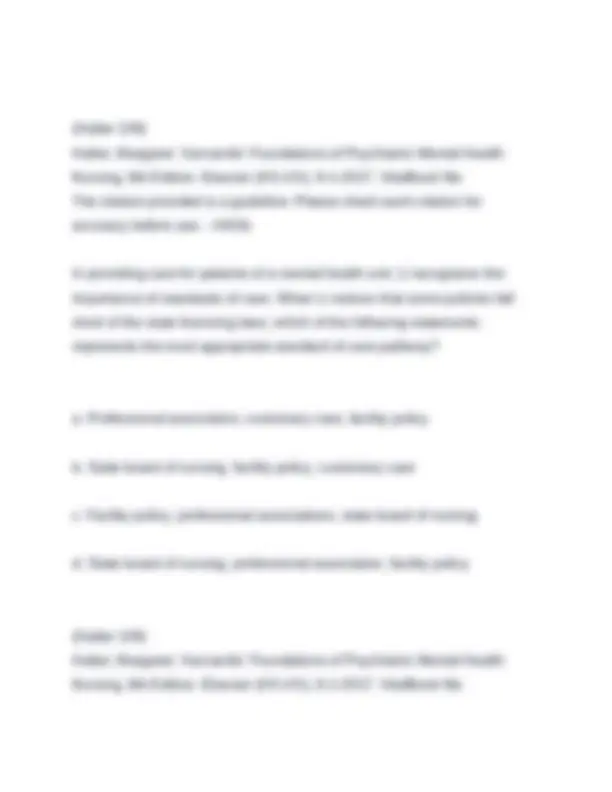
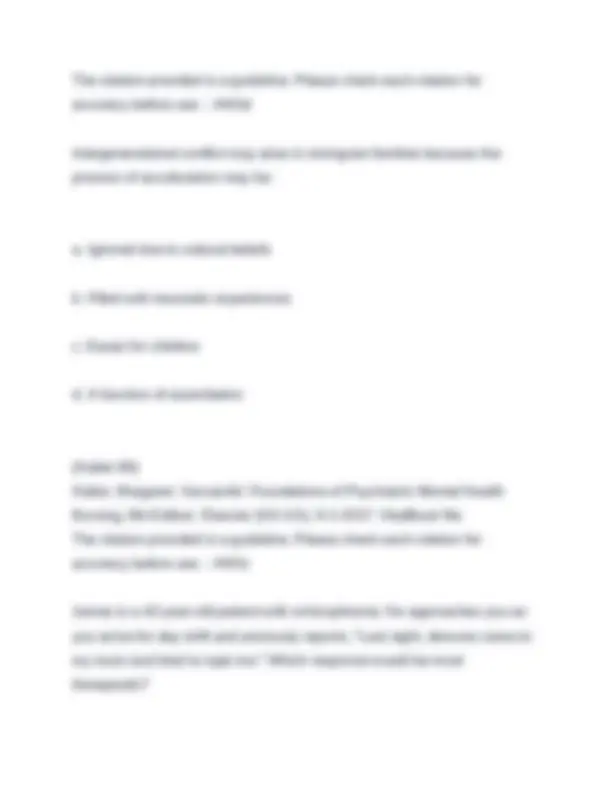

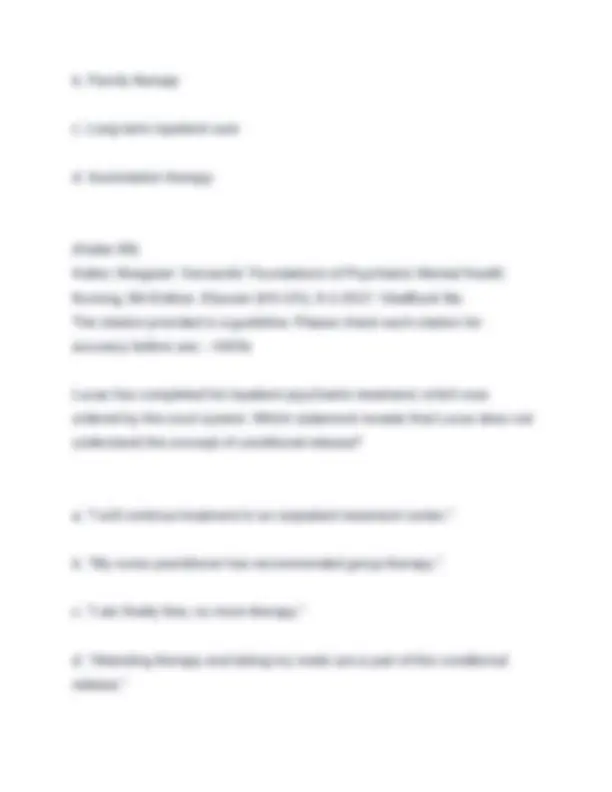
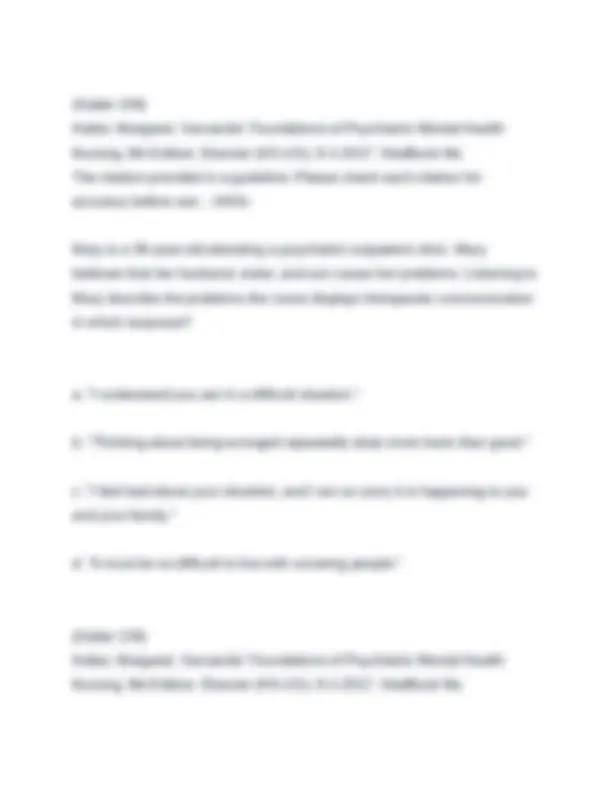
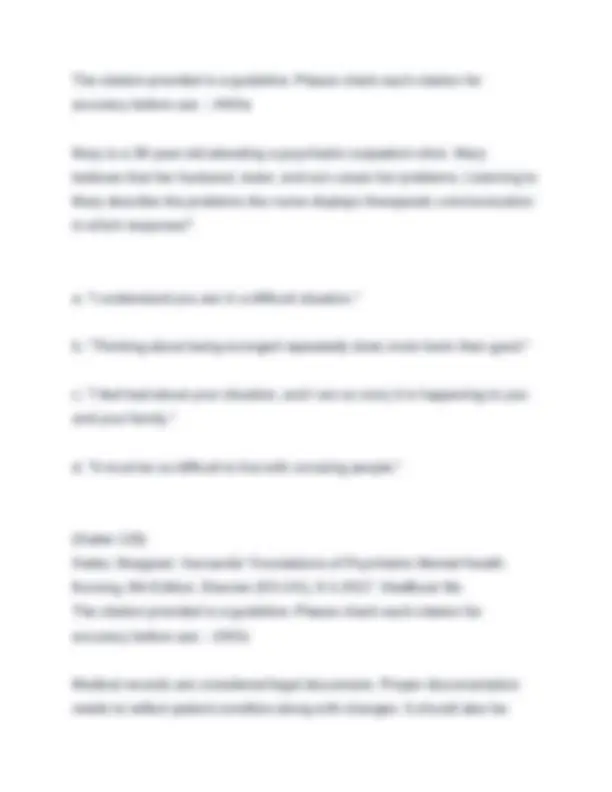
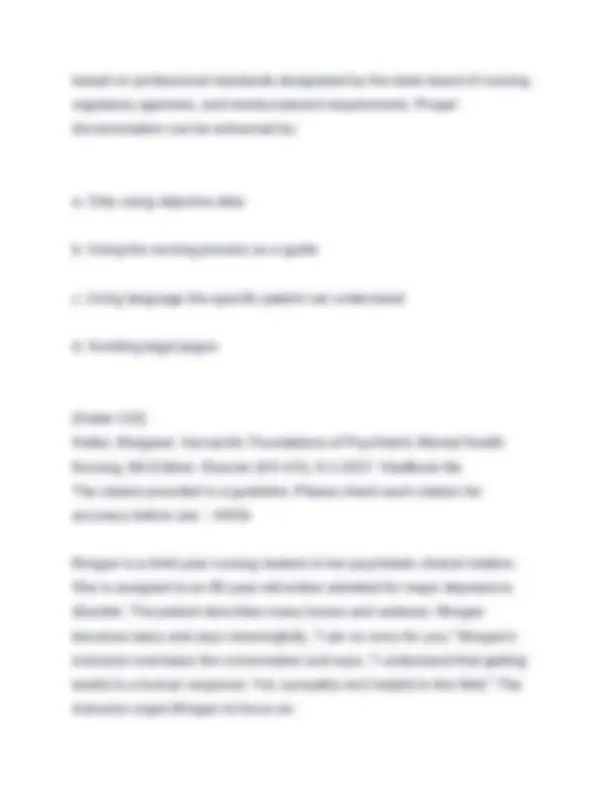
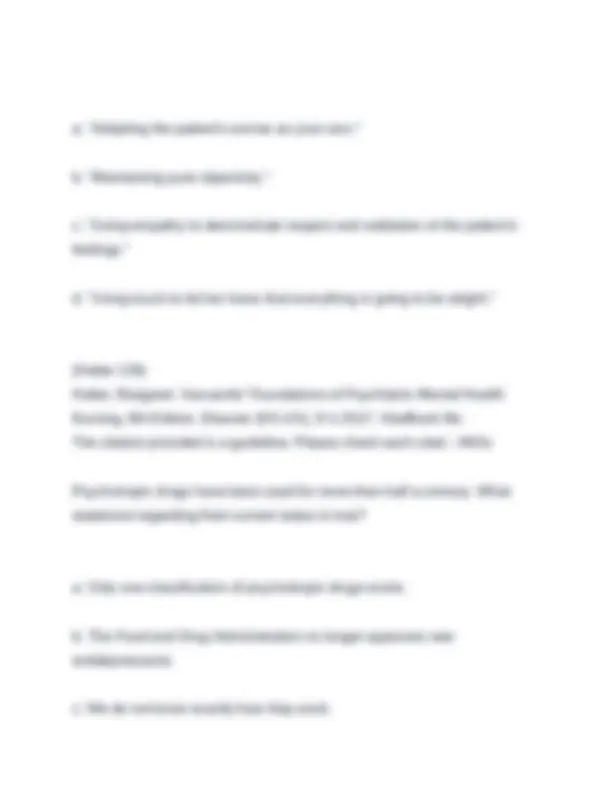
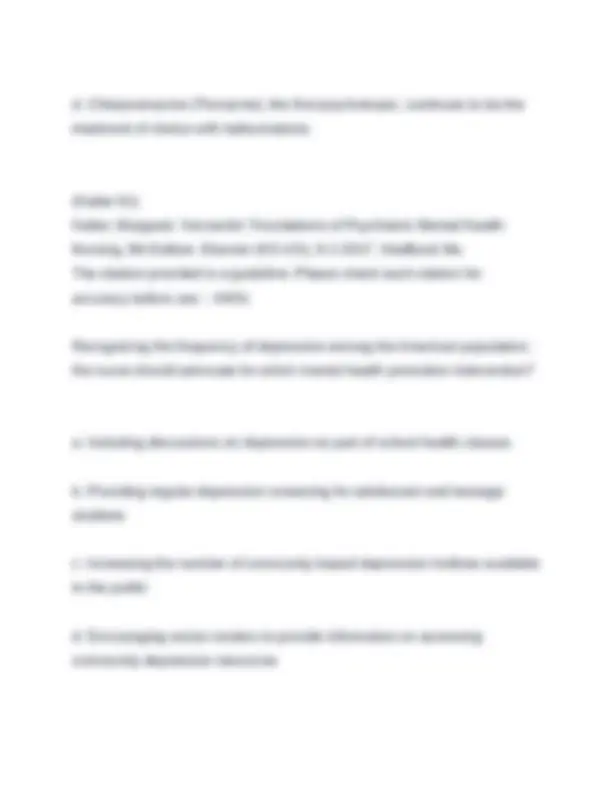
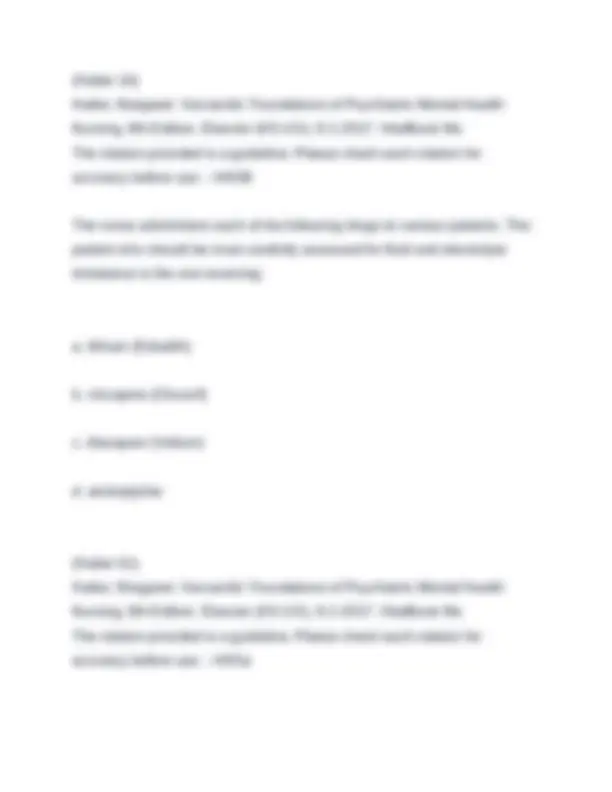
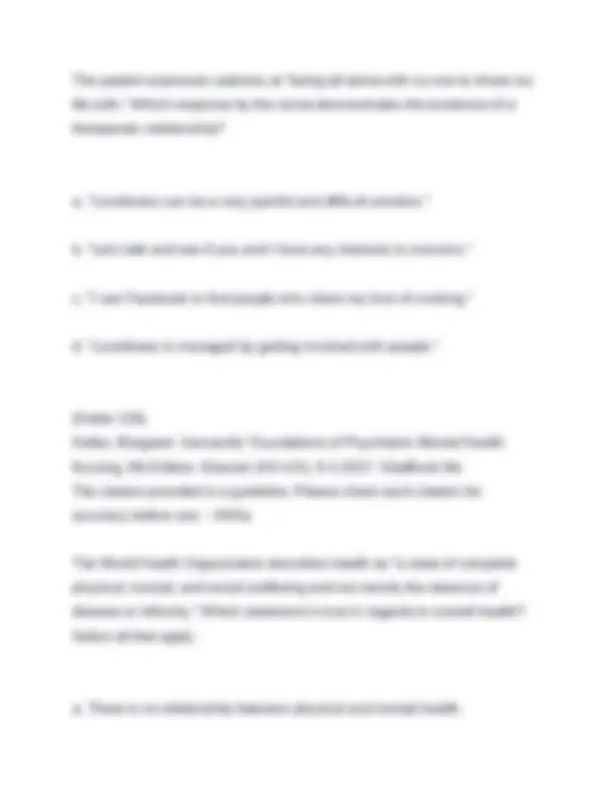
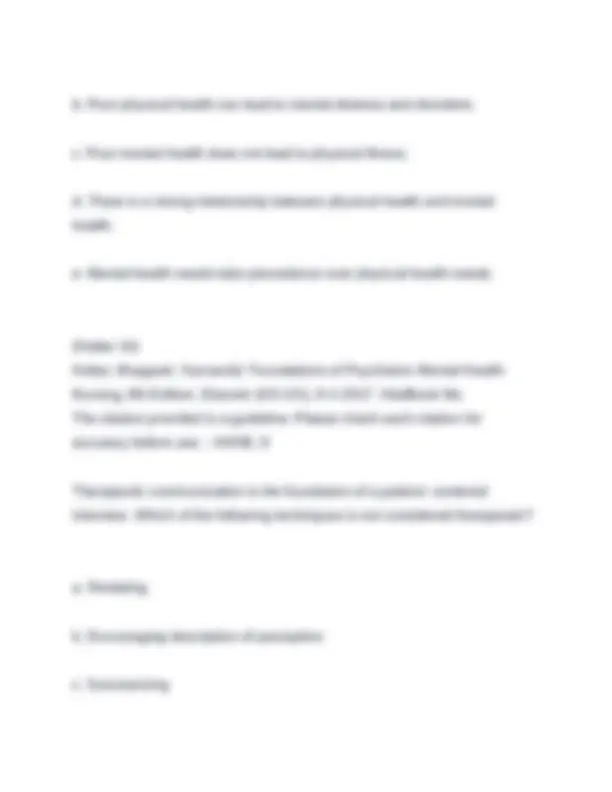
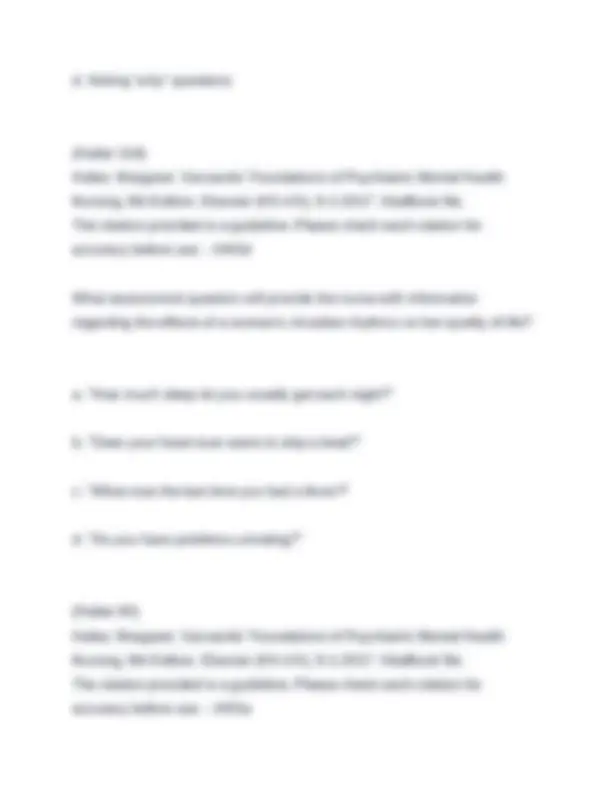
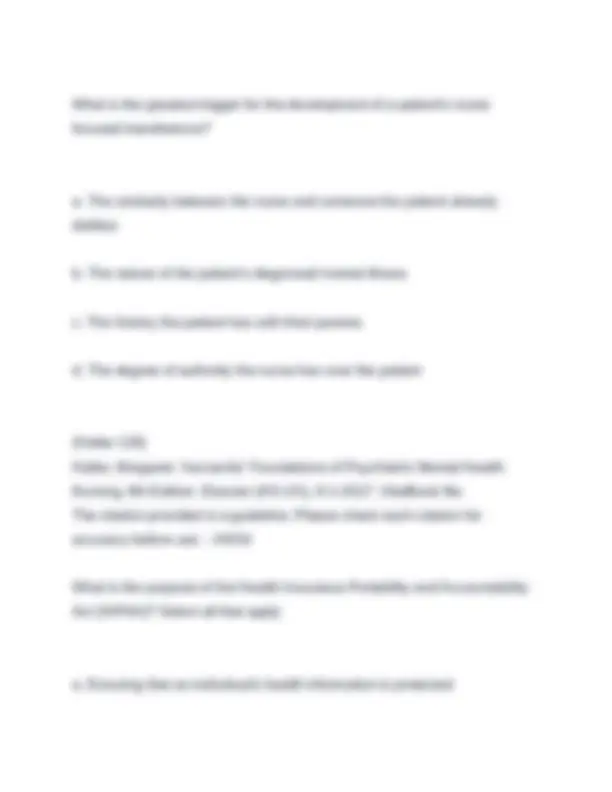
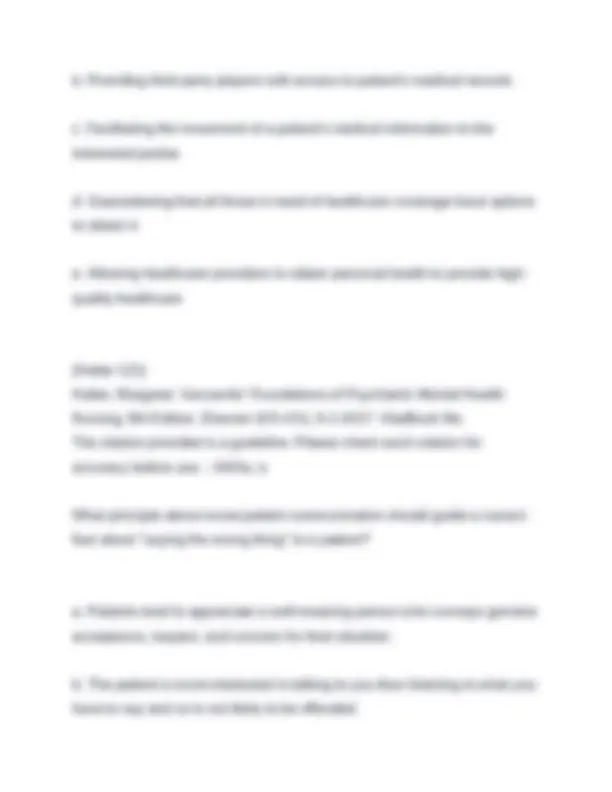
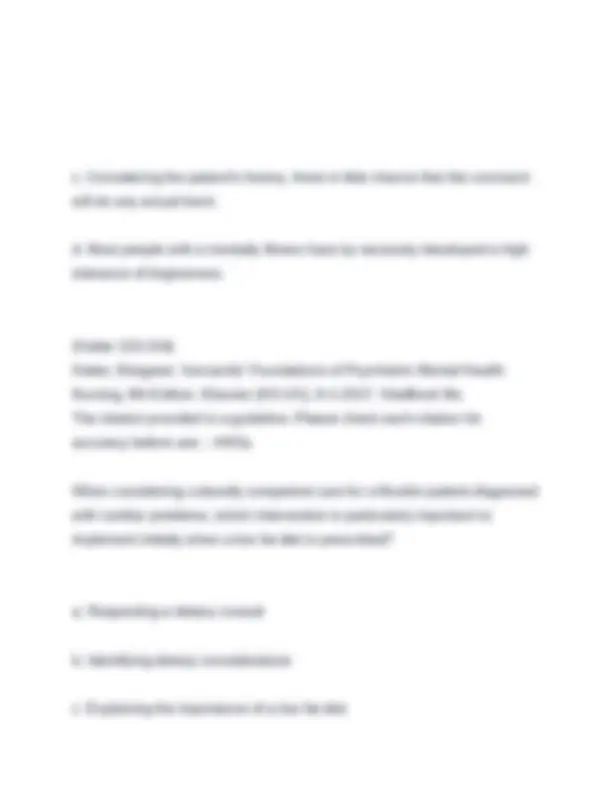
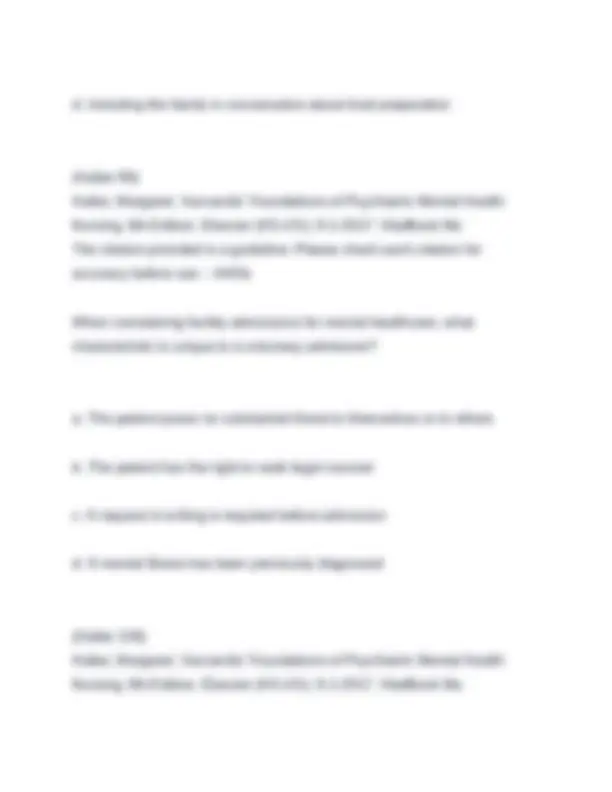
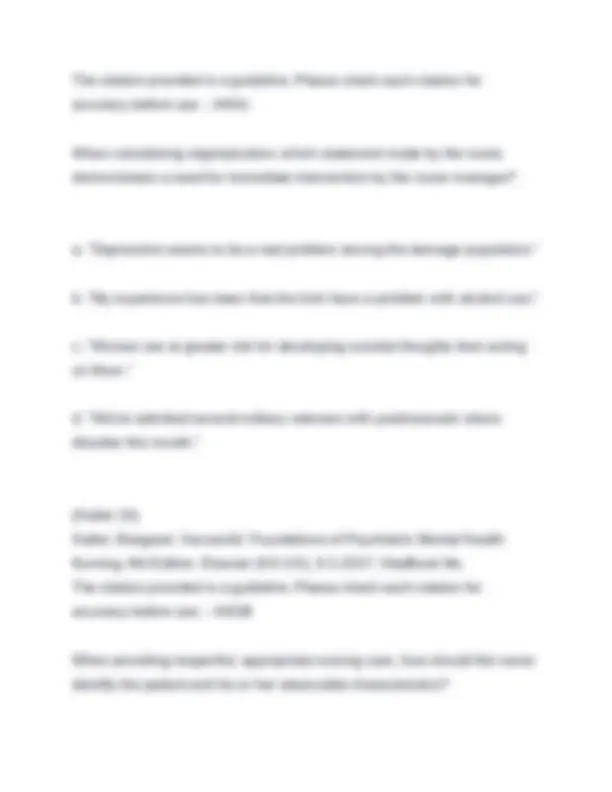
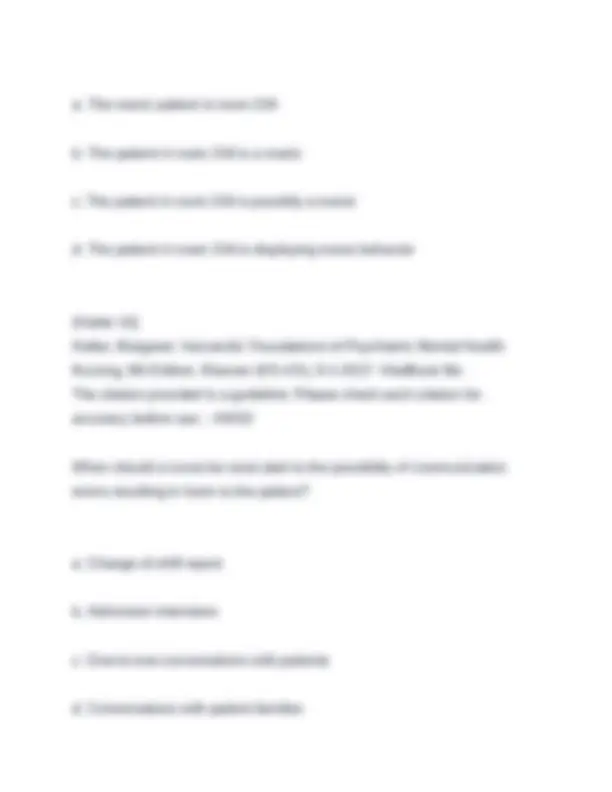
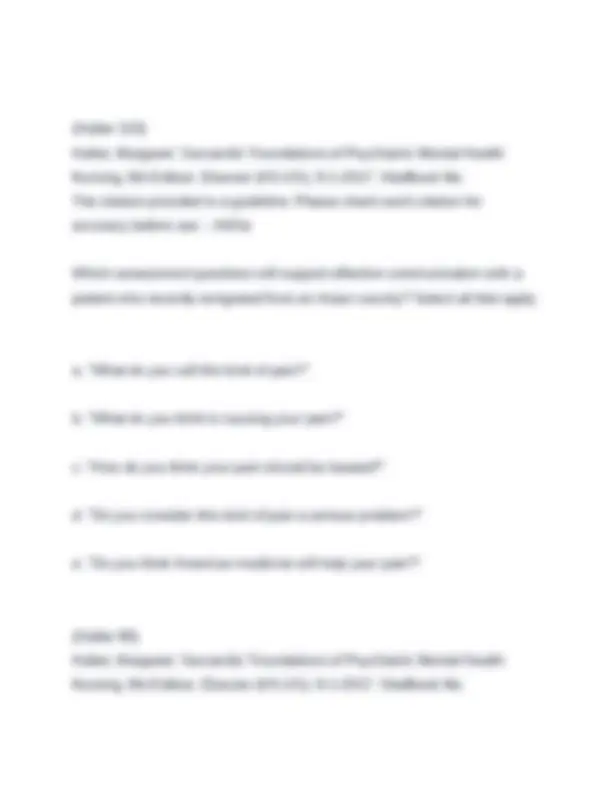
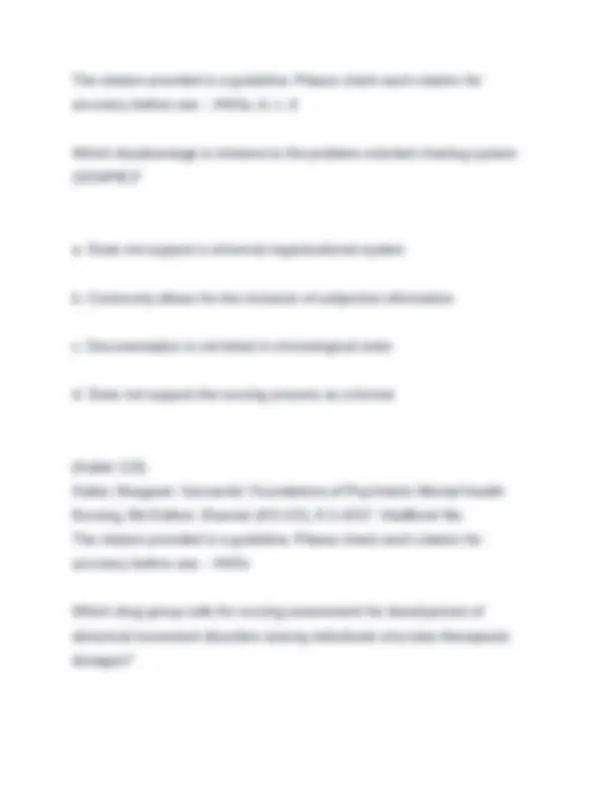
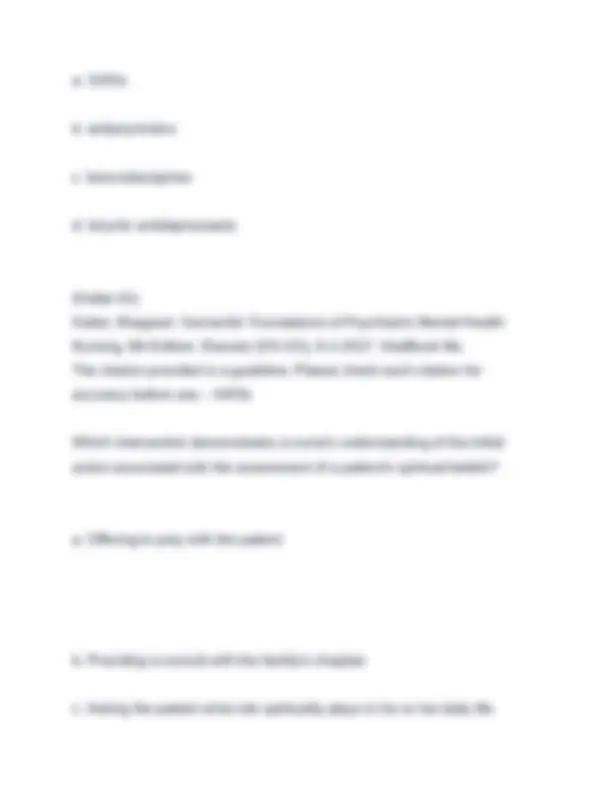
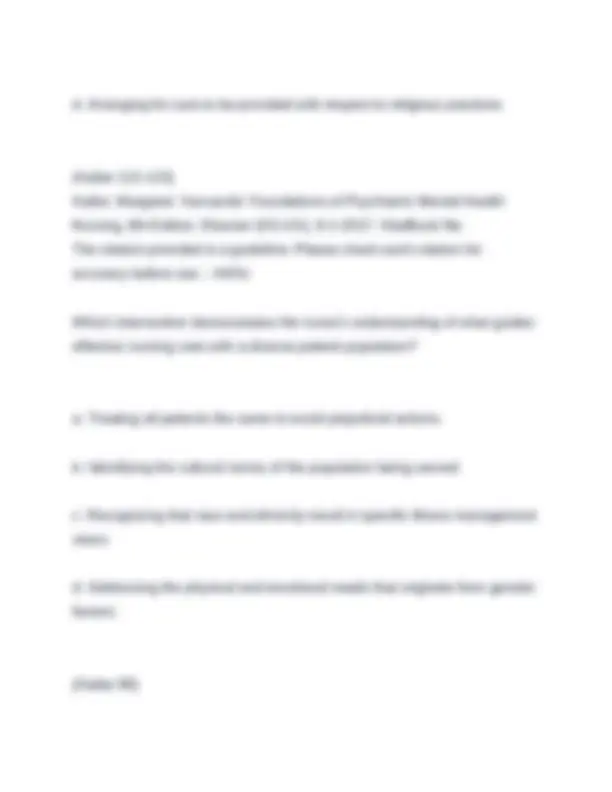
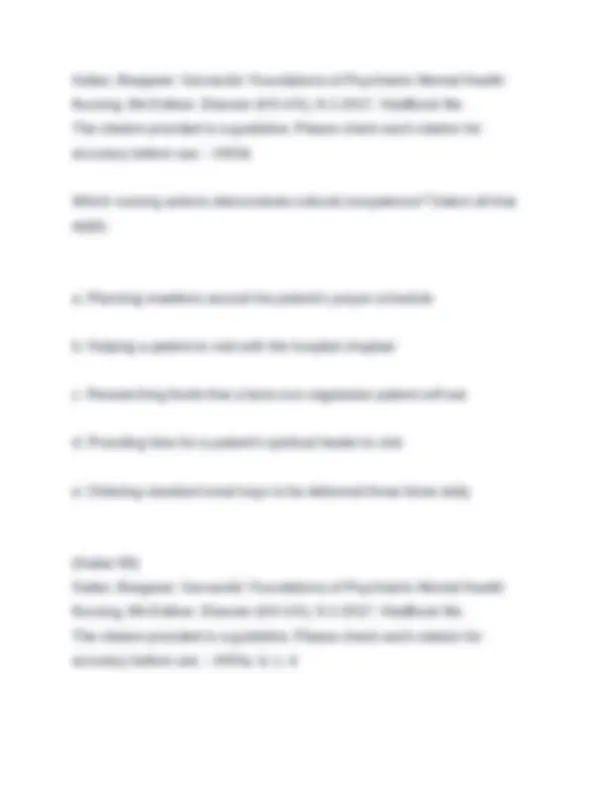
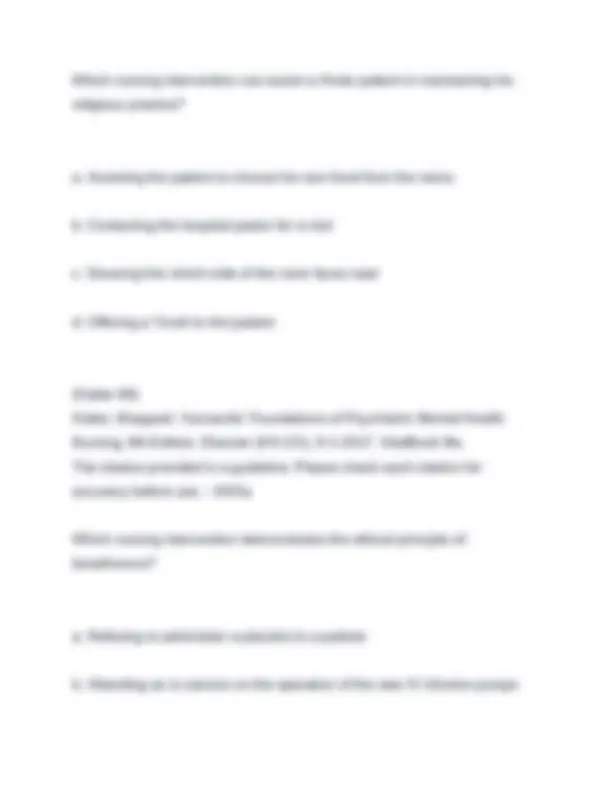
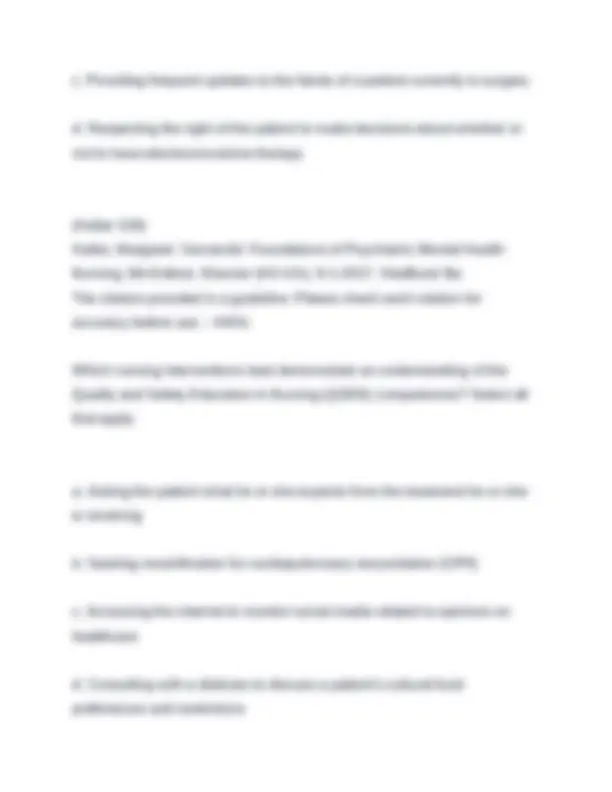
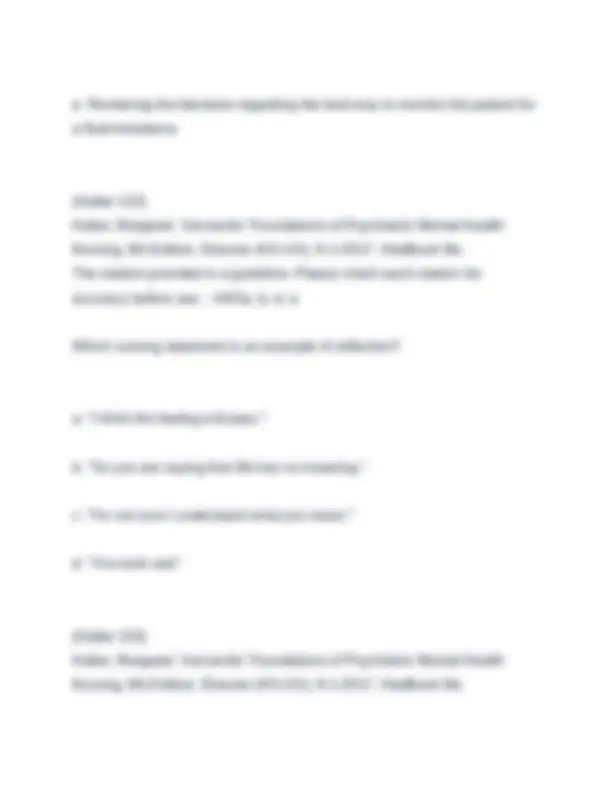
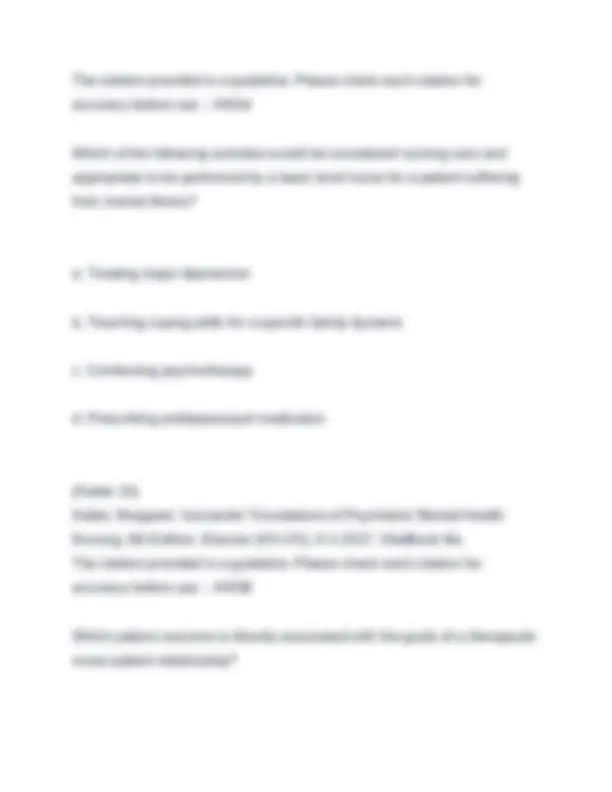
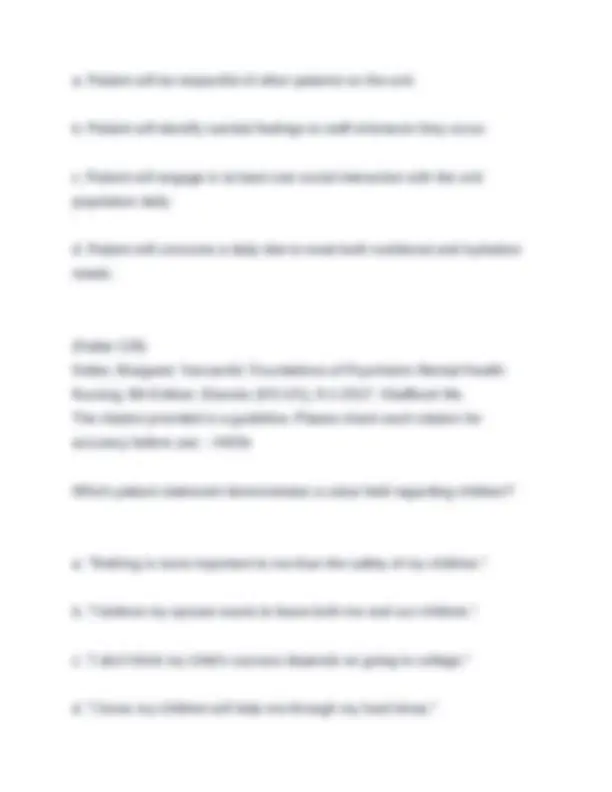
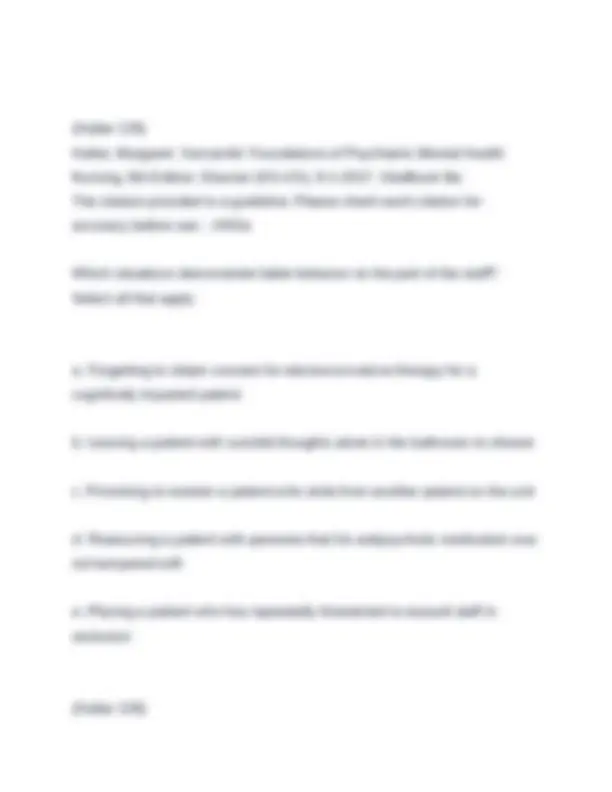
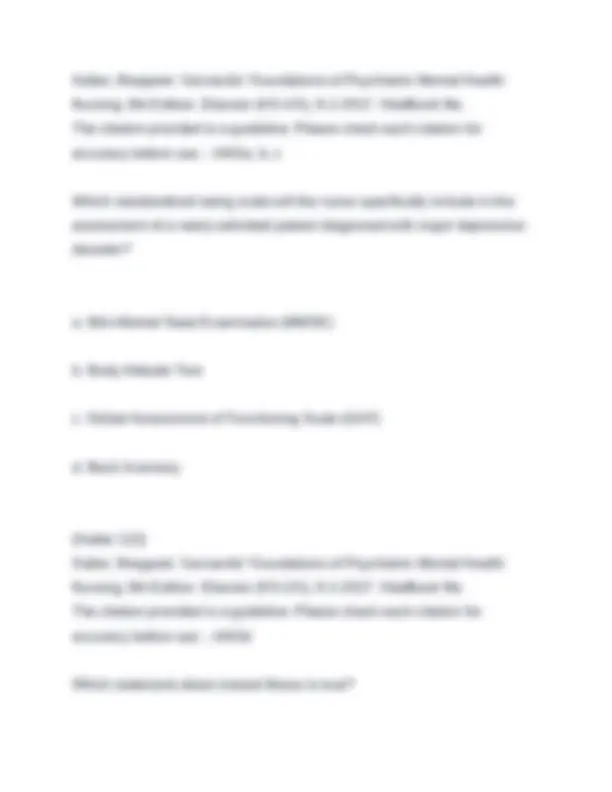
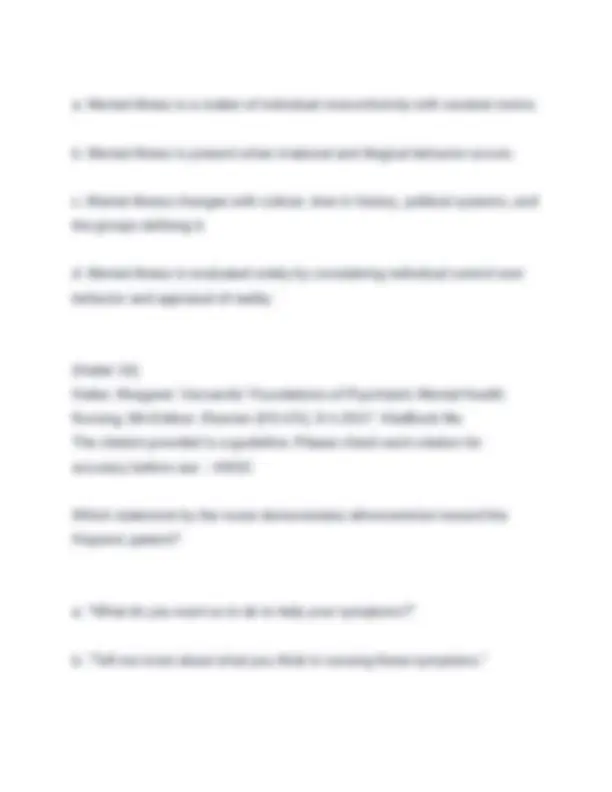
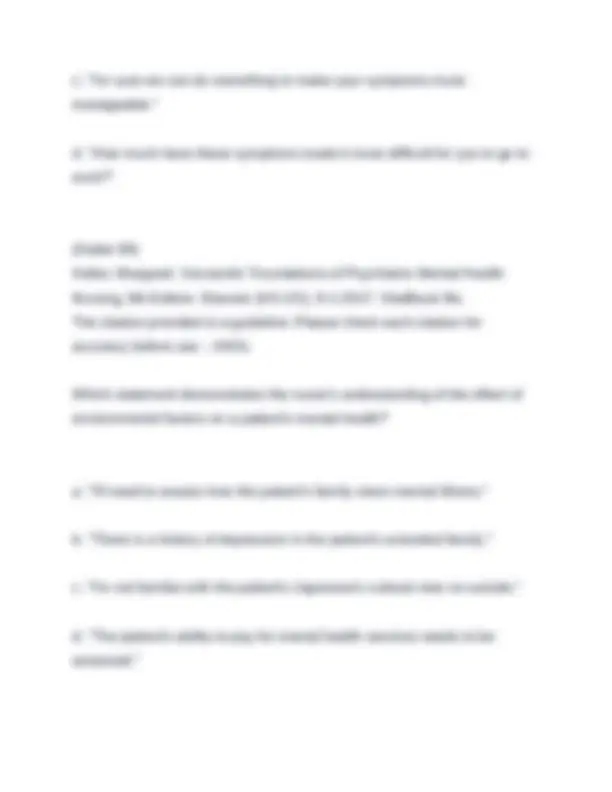
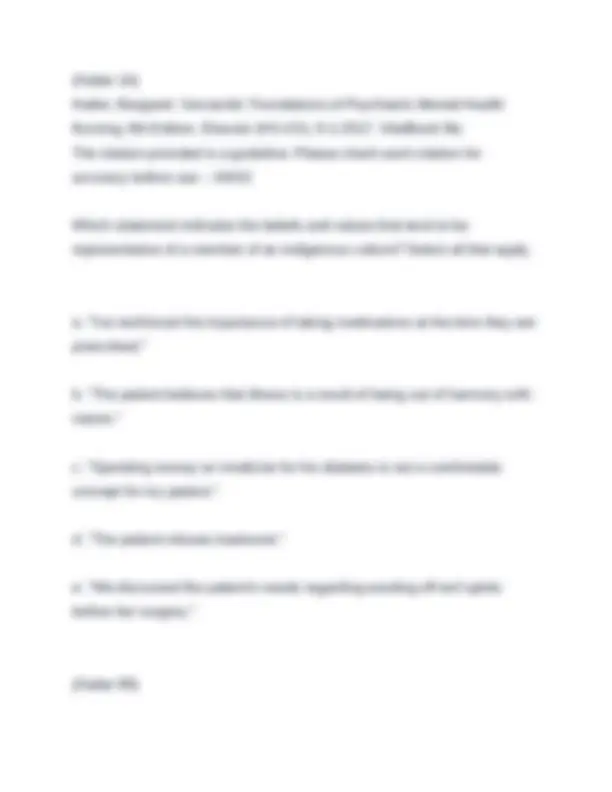
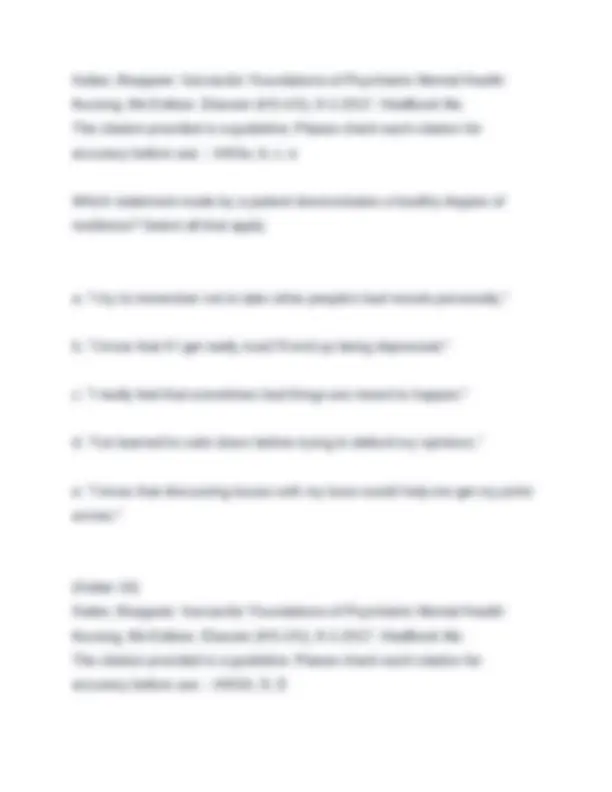
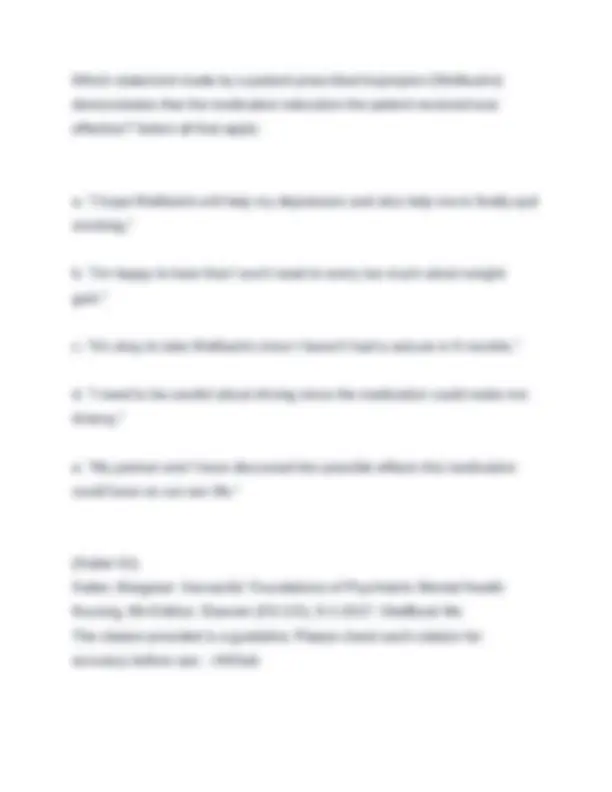
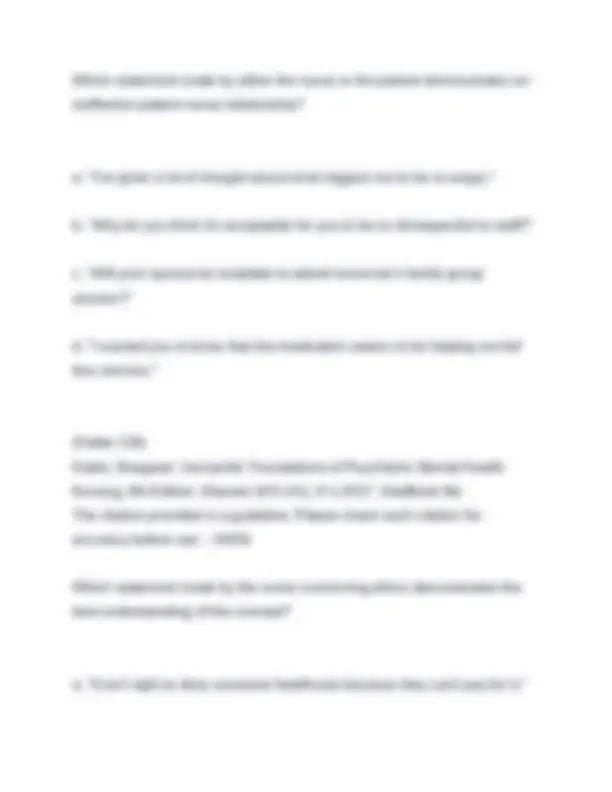
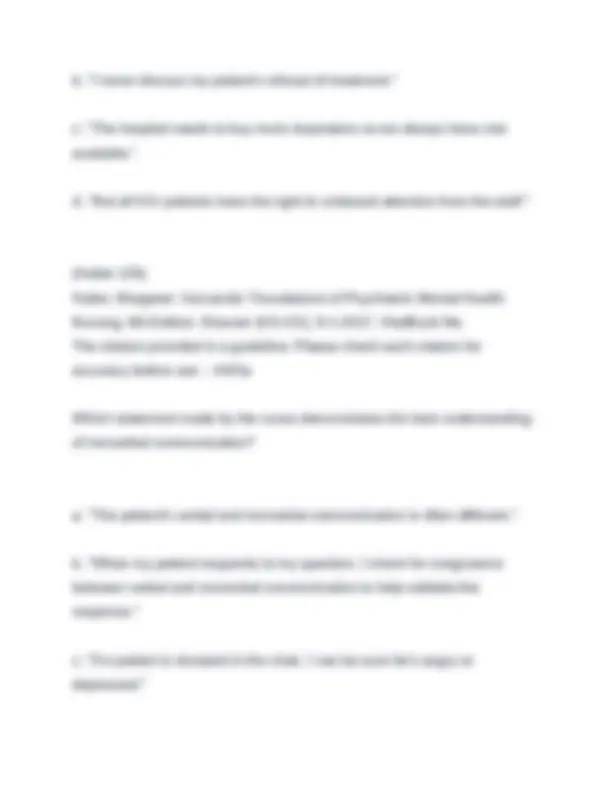
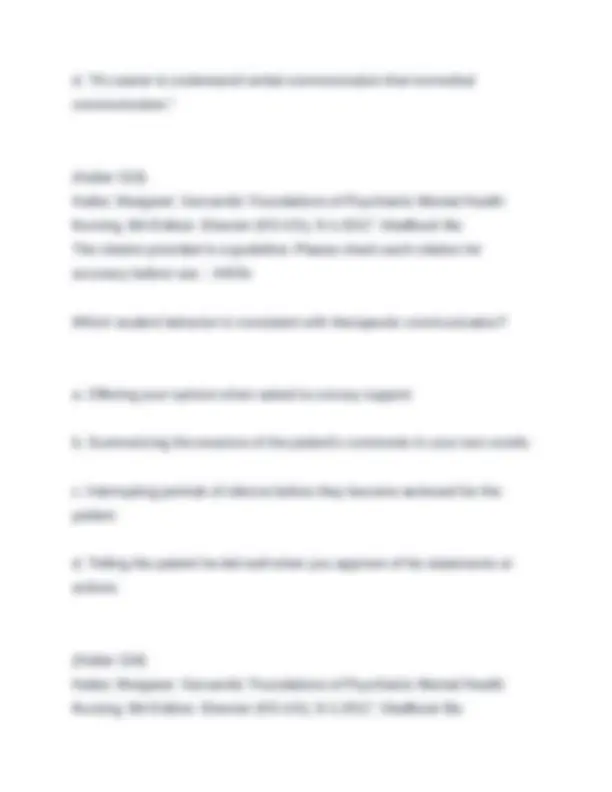
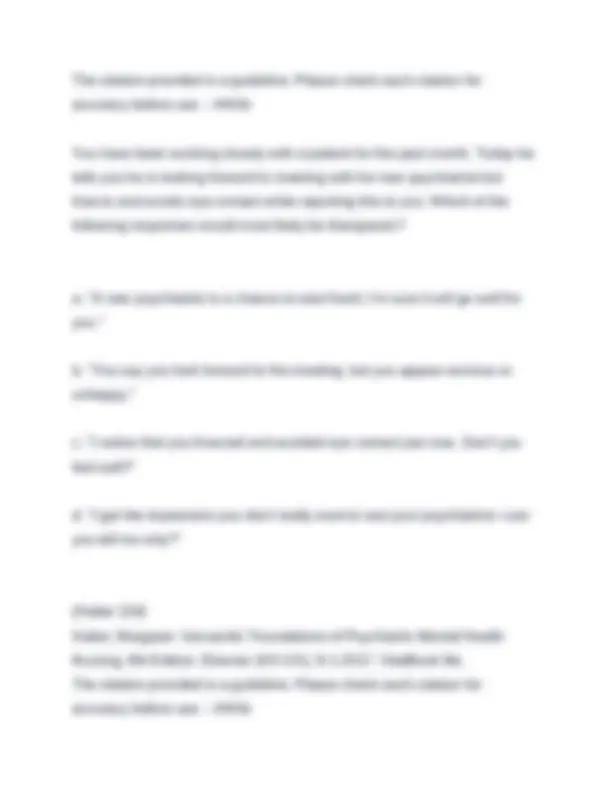
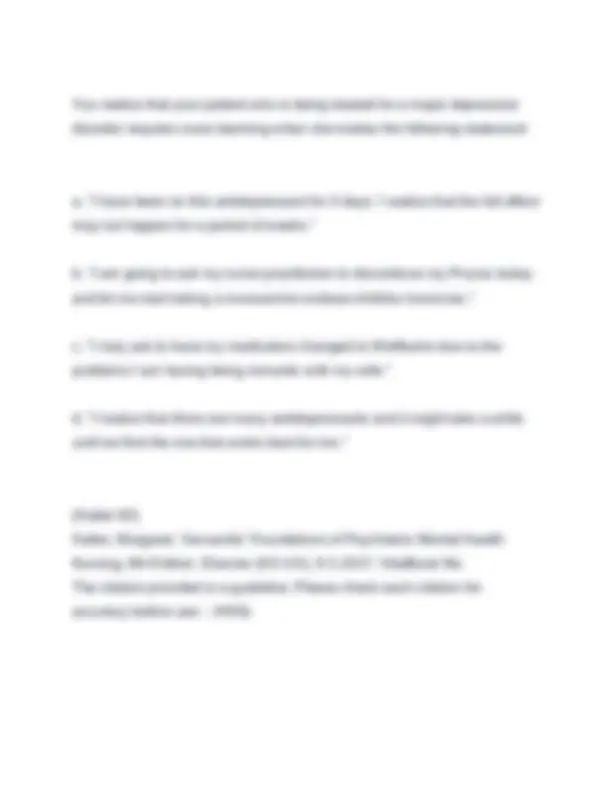


Study with the several resources on Docsity

Earn points by helping other students or get them with a premium plan


Prepare for your exams
Study with the several resources on Docsity

Earn points to download
Earn points by helping other students or get them with a premium plan
Community
Ask the community for help and clear up your study doubts
Discover the best universities in your country according to Docsity users
Free resources
Download our free guides on studying techniques, anxiety management strategies, and thesis advice from Docsity tutors
Varcarolis, Psychiatric Nursing: Exam 1 Application Latest 2025-2026. Questions & Correct Answers. Graded A
Typology: Exams
1 / 66

This page cannot be seen from the preview
Don't miss anything!



























































b. "I spend most of my time studying. I have to get into a good college." c. "I'm not trying to diet, but I've lost about 5 pounds in the past 5 months." d. "I go to sleep around 11 p.m. but I'm always up by 3 a.m. and can't go back to sleep." - ANSD
c. "Do you have a history of disordered eating?" d. "Do you think that you drink too much?" e. "Have you ever been arrested for committing a crime?" - ANSB,C,D
d. Set limits on the angry behavior that will be tolerated. e. Allow any expression of anger as long as no one is hurt. - ANSA,B,D
inpatient therapy. Tammy is taking citalopram (Celexa) and reports that it has made her feel more hopeful. With a secondary diagnosis of bulimia nervosa, what is an alternative antidepressant to consider? a. Fluoxetine (Prozac) b. Isocarboxazid (Marplan) c. Amitriptyline d. Duloxetine (Cymbalta) - ANSA
a. Meditate in the quiet environment b. Ask simple questions even if the patient will not answer c. Use the technique of making observations d. Simply sit quietly and leave when the patient falls asleep - ANSC
c. A young single white male who is alcohol dependent, hopeless, impulsive, has just been rejected by his girlfriend, and has ready access to a gun he has hidden. d. An older Hispanic male who is Catholic, is living with a debilitating chronic illness, is recently widowed, and who states, "I wish that God would take me too." - ANSC A 13-year-old boy is undergoing a mental health assessment. The nurse practitioner assures him that his medical records are protected and private. The nurse recognizes that this promise cannot be kept when the youth divulges: a. "I lost my virginity last year." b. "I am angry with my parents most of the time." c. "I have thoughts of being in love with boys." d. "My parents do not know that I hit my grandpa." (Halter 122) Halter, Margaret. Varcarolis' Foundations of Psychiatric Mental Health Nursing, 8th Edition. Elsevier (HS-US), 9-1-2017. VitalBook file. The citation provided is a guideline. Please check each citation for accuracy before use. - ANSd
self-inflicted cuts on her forearms and inner thighs. What is the most important patient outcome for this nursing diagnosis? a. Identify triggers to self-mutilation b. Demonstrate a decrease in frequency and intensity of cutting c. Describe strategies in increase socialization on the unit d. Describe two strategies to increase self-care (Halter 122) Halter, Margaret. Varcarolis' Foundations of Psychiatric Mental Health Nursing, 8th Edition. Elsevier (HS-US), 9-1-2017. VitalBook file. The citation provided is a guideline. Please check each citation for accuracy before use. - ANSa A nurse makes a post on a social media page about his peer taking care of a patient with a crime-related gunshot wound in the emergency department. He does not use the name of the patient. The nurse: a. Has not violated confidentiality laws because he did not use the patient's name.
b. Cannot be held liable for violating confidentiality laws because he was not the primary nurse for the patient. c. Has violated confidentiality laws and can be held liable. d. Cannot be held liable because postings on a social media site are excluded from confidentiality laws. (Halter 106) Halter, Margaret. Varcarolis' Foundations of Psychiatric Mental Health Nursing, 8th Edition. Elsevier (HS-US), 9-1-2017. VitalBook file. The citation provided is a guideline. Please check each citation for accuracy before use. - ANSc A nurse practitioner is interviewing a female patient from Southeast Asia. She complains of stomach pain and chest discomfort. Knowing that the patient's adult son died in a car accident last month, the nurse suspects: a. Vulnerability b. Acid reflux c. Somatization d. Transference
A nursing student new to psychiatric-mental health nursing asks a peer what resources he can use to figure out which symptoms are present in a specific psychiatric disorder. The best answer would be: a. Nursing Interventions Classification (NIC) b. Nursing Outcomes Classification (NOC) c. NANDA-I nursing diagnoses d. DSM- (Halter 16) Halter, Margaret. Varcarolis' Foundations of Psychiatric Mental Health Nursing, 8th Edition. Elsevier (HS-US), 9-1-2017. VitalBook file. The citation provided is a guideline. Please check each citation for accuracy before use. - ANSD A patient being treated for insomnia is prescribed ramel-teon (Rozerem). Which comorbid mental health condition would make this medication the hypnotic of choice for this particular patient? a. Obsessive-compulsive disorder
b. Generalized anxiety disorder c. Persistent depressive disorder d. Substance use disorder (Halter 61) Halter, Margaret. Varcarolis' Foundations of Psychiatric Mental Health Nursing, 8th Edition. Elsevier (HS-US), 9-1-2017. VitalBook file. The citation provided is a guideline. Please check each citation for accuracy before use. - ANSd A psychiatric nurse is reviewing prescriptions for a patient with major depression at the county clinic. Since the patient has a mild intellectual disability, the nurse would question which classification of antidepressant drugs: a. Selective serotonin reuptake inhibitors b. Monoamine oxidase inhibitors c. Serotonin and norepinephrine reuptake inhibitors d. All of the above
The citation provided is a guideline. Please check each citation for accuracy before use. - ANSa, b, d Based on Maslow's hierarchy of needs, physiological needs for a restrained patient include: Select all that apply. a. Private toileting, oral hydration b. Checking the tightness of the restraints c. Therapeutic communication d. Maintaining a patent airway (Halter 106) Halter, Margaret. Varcarolis' Foundations of Psychiatric Mental Health Nursing, 8th Edition. Elsevier (HS-US), 9-1-2017. VitalBook file. The citation provided is a guideline. Please check each citation for accuracy before use. - ANSa, b, d Besides antianxiety agents, which classification of drugs is also commonly given to treat anxiety and anxiety disorders?
a. Antipsychotics b. Mood stabilizers c. Antidepressants d. Cholinesterase inhibitors (Halter 60) Halter, Margaret. Varcarolis' Foundations of Psychiatric Mental Health Nursing, 8th Edition. Elsevier (HS-US), 9-1-2017. VitalBook file. The citation provided is a guideline. Please check each citation for accuracy before use. - ANSc Carolina is surprised when her patient does not show for a regularly scheduled appointment. When contacted, the patient states, "I don't need to come see you anymore. I have found a therapy app on my phone that I love." How should Carolina respond to this news? a. "That sounds exciting, would you be willing to visit and show me the app?" b. "At this time, there is no real evidence that the app can replace our therapy."